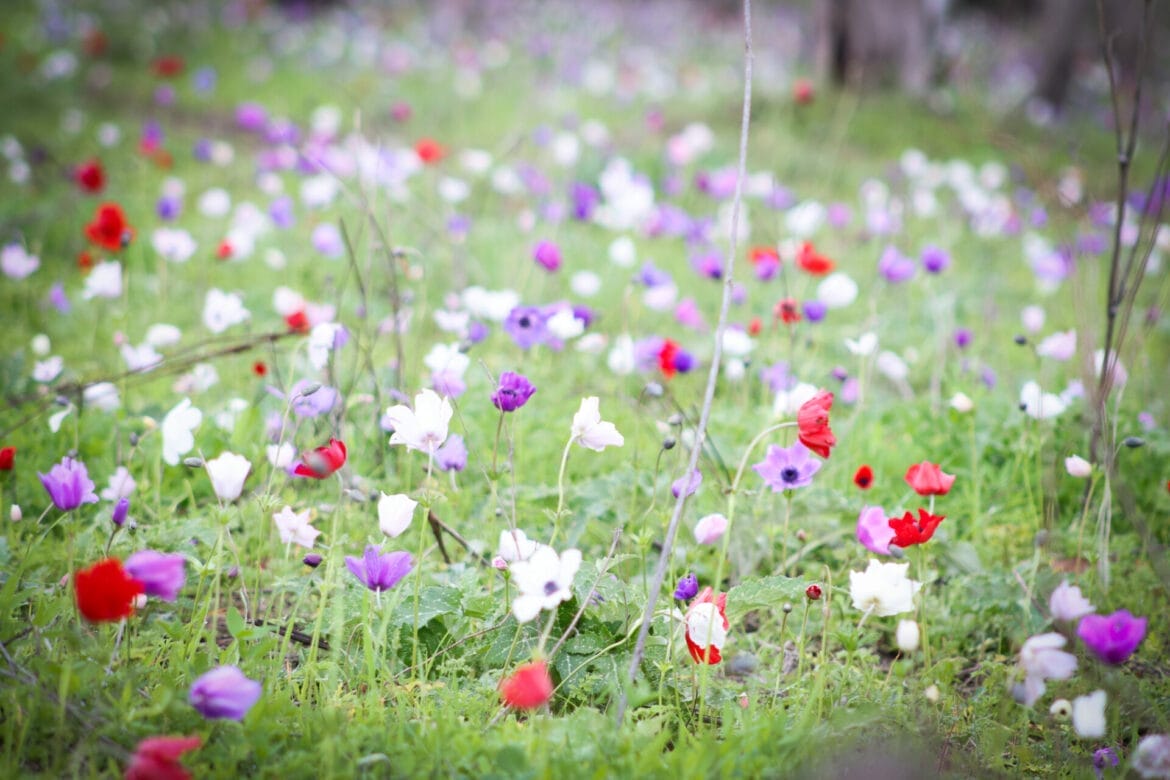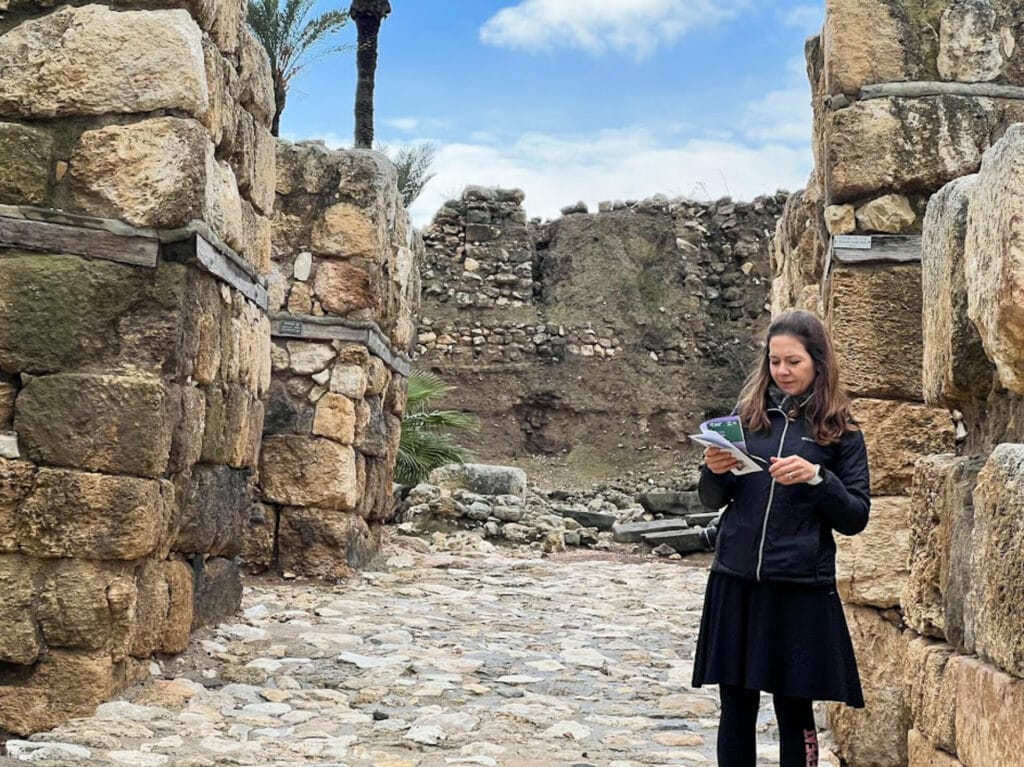
| Distance: <1km | Time: 3 hours | Difficulty: Easy |
Click here to go straight to hike notes.
It’s springtime! Can’t you tell?
Well, maybe it’s not actually springtime. Judging from the fierce winds, stormy weather, and the fact that the calendar is opened up to the month of February, it’s wintertime right now. But a crazy thing happens in Israel in wintertime: multi-colored flowers start to sprout from the once monotone earth. In Israel in the wintertime, outdoor enthusiasts (or anyone who loves flowers) must capitalize on the nicer days and get out to catch some of these blossoms before they disappear.
And that’s just what we did yesterday, the one (mostly) non-rainy day in a two-week period of rainy weather. From the weather report, we saw that the day would be drizzly at most. So, we planned a flower peeping adventure in the Jezreel Valley.
Our Adventure
Our multi-part journey included a trip to fields of flowers, a visit to the famous Tel Megiddo, and a hike in Ramot Menashe (which I’ll be covering in another post).
At Minhat Megiddo, multi-colored anemone flowers blossom in abundance. These are the types of anemones that you don’t usually see in the southern part of the country, where red flowers are the stars of the show. We visited Minhat Megiddo early in the morning, and it really was beautiful. So much so that we had a hard time pulling ourselves away to move on to part two of our adventure.

Nearby ancient Tel Megiddo was a super cool adventure all on its own. This Biblical city turned National Park had a rich and important history, even before being part of the Israelite kingdom. Since Megiddo sat on the crossroads between Egypt and Mesopotamia in the fertile plain known as the Jezreel Valley, it was well populated for thousands of years.
Put together, these two sites made a wonderful morning adventure. Here’s how we walked at Minhat Megiddo and Tel Megiddo:
Flowers First
It’s always a surprise when you set off on a flower peeping adventure. There’s no really good way of knowing whether the blossoms will be out in full force or just starting to peek up from the ground.
We stepped out of the car and into a quiet forest. After our first steps on the path, it was clear that we had come at the right time. Less than a week into the month of February, the anemone flowers were already blooming in abundance.

We made slow progress on the walking trail as we stopped to take photo after photo. There were so many colors: pinks, purples, whites, and bright reds, mixed with rebellious yellow flowers for good measure. The wind blew through the trees and the grass, making the flowers dance. Although the sky was overcast and the weather drizzly, the anemones radiated happiness. Their little wind dance seemed to call us to join in on the fun.
Next Stop: Tel Megiddo!
Just past the fields of flowers, we could see a row of helicopters and a low building. This place, Minhat Megiddo, is actually the Megiddo Airfield.
It was built by the British in the early 1940’s for use in the Second World War, along with several other airfields around the country. Later on, the space was turned into a private flight school. The popular anemone fields bear the unromantic name of the airstrip.

After much contemplation of the beautiful scenery at Minhat Megiddo, it was time to complete the footpaths and head back towards the car. Next stop, Tel Megiddo, just a short drive away.

To an Ancient City
There are hundreds of tels in Israel. These little hills are made up of layers upon layers of ancient settlements, resulting in a mound full of archeological wonders, some of which are still waiting to be explored.
But of the tels in Israel, Tel Megiddo is one of the most important. Megiddo, aside from being a city mentioned in many stories in the Bible, was also a large Canaanite city, well documented by the Egyptians for its importance in the area. In the 15th centure BCE, the Canaanite city was captured by the Egyptian Pharoah after a seven month long siege. The opulence of the city is depicted in the description of the booty taken at battle: 924 chariots, 2238 horses, a golden throne, and plentiful cattle and wheat.

Later on, Megiddo was mentioned in the book of Joshua as one of the cities that the Israelites were unable to capture. But further along in the books of the Prophets, we see Megiddo mentioned as a city under King Solomon’s rule. Eventually, King Hoshea (Josiah) was killed at Megiddo, when it was captured by the Assyrian King Tiglath Pilesar III in 732 BCE.
It’s interesting to note that Megiddo is the basis for the New Testament final battle at Armageddon (from the words Har-Megiddo, or mountain of Megiddo). This idea seems to be based on passages from the book of Zechariah, where the prophet describes such a battle in the Megiddo Valley.
A Visit to the Tel
After showing our parks card and picking up a map, we followed the trail through Tel Megiddo along a clearly marked path. Numbered signs appeared at different points throughout the park, each with a corresponding explanation on the map.

We passed through the ancient gated entrance, then made our way through the different layers of the ancient city. There was an old granary, a destroyed temple, and even an Israelite home, its pillars standing upright. On top of our walk through history, we got to enjoy the lush, green views of the Jezreel valley just beyond the Tel. It was beautiful up there.
Highlights
Past rows of date palms and horse stables, we discovered the entrance to an ancient water system, the highlight of any trip to Tel Megiddo. This water system is made up of layers of building, from different time periods throughout history.
We climbed down the many steps to the large cistern where water was held. Then, we followed a secret tunnel which led outside of the city, towards a spring. Throughout history, this spring was used as the city’s water source. The secret tunnel was built so that Megiddo’s residents could access water without actually leaving the city.

Finally, we found ourselves in the cave with the spring. From here, we climbed many steps to exit the ancient city of Megiddo.
Only in Israel
As we made our way towards the entrance and our last stop at the Tel Megiddo museum, I couldn’t help but think about how special our morning had been. Only in Israel: February wildflower explosions and layers of ancient history come together to form a beautiful adventure in a fertile valley that’s been sought after throughout the ages.
Our journey to Minhat Megiddo and Tel Megiddo had turned an average winter morning into a beautiful and fascinating exploration of history and nature.


Hikers’ Notes:
Here’s what you need to know to visit Manhat Megiddo and Tel Megiddo:
- Tel Megiddo is an all season site. Minhat Megiddo is only colorful and blossoming during the month of February.
- The links in the table at the top are for Minhat Megiddo. To get to Tel Megiddo, just put Megiddo National Park into Waze or Google Maps.
- Great for kids.
- Suitable for dogs.
- The trail at Minhat Megiddo can be a bit muddy after heavy rains.
- No need for directions of maps for these trails. Minhat Megiddo has a clearly marked, very short walking trail. At Tel Megiddo, you will receive a park map and instructions at the entrance.
- There is an entrance fee (or use your parks card) to visit Tel Megiddo. You'll find a store, a restaurant, and facilities at the site. You can reserve your visit right here.
Don’t forget to read my guide to the navigational features in this post before you hit the trail!
Questions? Have you been to Minhat Megiddo or Tel Megiddo? Let’s hear about it in the comments!







where did you walk on a well marked path? we went today and couldn’t find any markings at all. so we just walked up a white dirt road a bit and turned around and went home. only saw the planes and helicopters from a distance behind trees and a fence